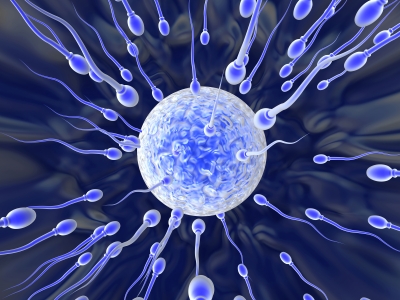What Really Motivates Sperm

In high-school health class films, sperm cells are shown zooming around with quick flicks of their tails, but they only jump into action when they are in the right chemical conditions – usually that's in the female reproductive tract. Researchers have now figured out the precise chemical switch that turns on the sperm's motors, which could lead to the development of new treatments for infertility.
Scientists have long known that sperm's activity level depends on the internal pH of the sperm cell —a measure of how acidic or alkaline a substance is. They start out with acidic insides when in the male reproductive tract, but once they enter the female tract, their internal environment becomes alkaline and off they zoom toward the egg.
That pH change occurs because the sperm release protons (acids are compounds that will donate a hydrogen ion — also known as a proton — to another compounds, called a base).
"The concentration of protons inside the [sperm] cell is 1,000 times higher than outside," said Yuriy Kirichok of the University of California, San Francisco, who was on the team that made the discovery. "If you just open a pore, protons will go outside. We identify the molecule that lets them out."
Sperm still in the male reproductive system are quiescent since there is no egg to go in search of. Kirichok likens them to balloons inflated with protons instead of air. If you open a hole in the sperm cell, protons will readily flow out.
The team has shown that each sperm's flagellum (or tail) is covered in many so-called Hv1 proton channels. When the channels are activated by external cues, the flood gates open and protons escape from many pores at once.
Kirichok said there are many conditions that open up the Hv1 pores, including alkaline conditions and the removal of zinc outside the cell.
Sign up for the Live Science daily newsletter now
Get the world’s most fascinating discoveries delivered straight to your inbox.
They also open when exposed to the endocannabinoid known as anandamide, a substance that is present in both the male and female reproductive tracts and that may be at particularly high levels in the vicinity of the egg.
That raises an interesting possibility, Kirichok said, because endocannabinoids are natural lipids that influence the activity of neurons. They are so named because they act on the same receptors that the active component of marijuana does. It remains to be shown, but that connection might explain why marijuana has been linked to male infertility.
"Marijuana likely activates sperm prematurely, leaving them burnt out in a matter of hours," Kirichok said. So instead of lying dormant until they enter the female reproductive tract, they may start moving around in the testes, expending all of their energy.
Perhaps most importantly, the newly discovered Hv1 channel may allow for new ways to modify the activity of sperm in either direction, Kirichok said. In fact, many key biochemical reactions in sperm depend on their internal pH levels, including the initial activation of sperm, hyperactivation once near the fallopian tubes, and the reaction in which enzymes are released to penetrate the egg.
"All of these events are essential to fertilization," Kirichok said. "You can imagine now that [if] we know the molecule responsible we could block it to prevent activation and fertilization as a kind of male contraception." On the other hand, you might also give some sperm the extra boost they need to make it to their goal.
The discovery is detailed in the Feb. 5 issue of the journal Cell.











